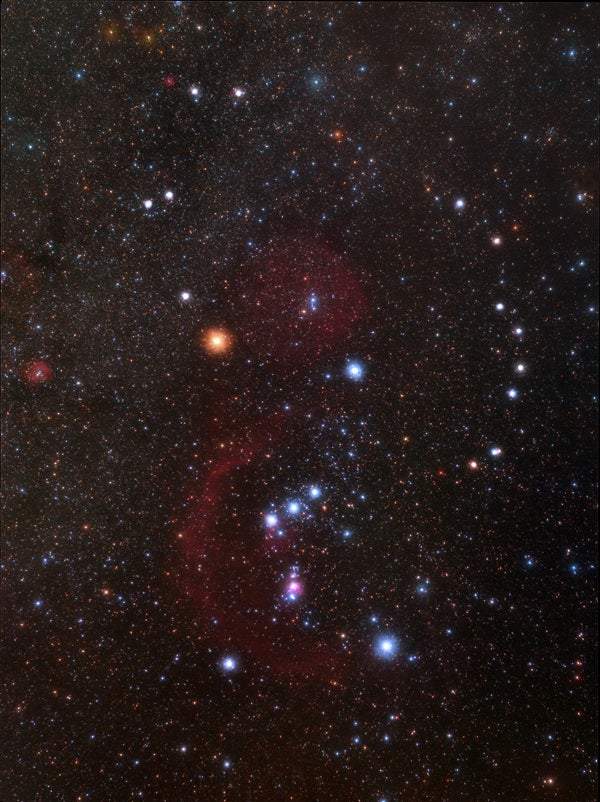But what my monochromatic terrestrial view may lack, the night sky more than makes up for: The winter sky abounds with colorful stars. This month, let’s take a tour of a few to add a little color back into our lives.
One of the most intensely colored stars anywhere in the sky is Orion’s Betelgeuse (Alpha [α] Orionis).
Betelgeuse has always led a colorful life. There was enough mass — probably 15 to 20 times that of our Sun — when it first came into being some 10 million years ago to create a blue type O main sequence star. But since then, Betelgeuse has squandered its nuclear fuel and evolved off the main sequence to the land of red supergiants, where we find it today. A casual glance through binoculars immediately displays its stunning ruddy color. Try softening the focus slightly to further amplify the hue.
Rigel (Beta [β] Orionis) is another vibrant sight through binoculars. Although designated as the constellation’s second brightest star, Rigel actually outshines Betelgeuse by a quarter magnitude. It’s classified as a spectacular blue-white supergiant. Through binoculars, the star gleams like an intense stellar sapphire, in stark color contrast to ruby-red Betelgeuse.
Aldebaran (Alpha Tauri) has a spectral type of K. It’s an orange giant star that also puts on a vivid show through binoculars. The effect stands out especially well against the backdrop of the Hyades Cluster. While it certainly appears as though Aldebaran belongs to the cluster, it’s just a chance, line-of-sight coincidence. The Hyades is about 150 light-years away, which makes it one of the closest open clusters to Earth. Aldebaran, however, lies at less than half that distance. Most of the stars in the Hyades appear white, although a few offer hints of yellow or orange. For instance, the binocular double star Theta1 (θ1) and Theta2 (θ2) Tauri displays contrasting colors of yellow and white, respectively.
Some of the most colorful stars in the sky are a special breed of type M red giants that vary in brightness as convective currents carry carbon material from deep within to the star’s surface, creating a carbon-rich outer layer. Just as particulate matter in our own atmosphere causes red sunsets and sunrises, this carbon layer scatters the blue end of the star’s visible light while allowing reds and oranges to pass into space and to our waiting eyes.
One of the best-known carbon stars is R Leporis, found about 7.5° south-southwest of Rigel. You may be familiar with it by its popular nickname, Hind’s Crimson Star, after British astronomer John Russell Hind, who discovered it in 1845. R Leporis varies in brightness from magnitude 5.5 to 11.7, with a period of 427 days. As is the case with most carbon stars, R’s redness is most impressive toward minimum brightness. That’s below most binocular thresholds, but you can still watch it on its way down. And that’s exactly what it’s doing now; R passed maximum in early November. As winter wears on, keep an eye on it as it dims and reddens toward the next minimum in late spring.
Let’s close out the first month of 2020 with a striking double star recommended by reader Robert Pickman. His suggestion is known as h3945, the 3,945th entry in a double star catalog with over 5,500 members, created by John Herschel in the early 19th century. It also carries the label 145 G Canis Majoris, the G indicating its designation in the 1879 Uranometria Argentina by Benjamin Gould. (Many references incorrectly omit the G.) Either way, it’s located 3.6° northeast of Wezen (Delta [δ] Canis Majoris), the large dog’s tailbone.
There, we discover a coincidental pairing of a 5.0-magnitude primary sun with a 5.9-magnitude companion separated by 26.8″. That’s tight by binocular standards, but theoretically possible under ideal sky conditions at 10x. I’ve never had luck splitting them with my 10x50s, but regularly do so in my 16x70s. One look through the latter and it’s clear why h3945 is nicknamed the Winter Albireo: The brighter star shines with a golden radiance, while the companion looks icy blue. My fellow Astronomy columnist Glenn Chaple once wrote that h3945 is “one of the most colorful, yet underrated, double stars in the heavens.”
Do you have a favorite target you’d like to share with the rest of us? Contact me through my website, www.philharrington.net.










